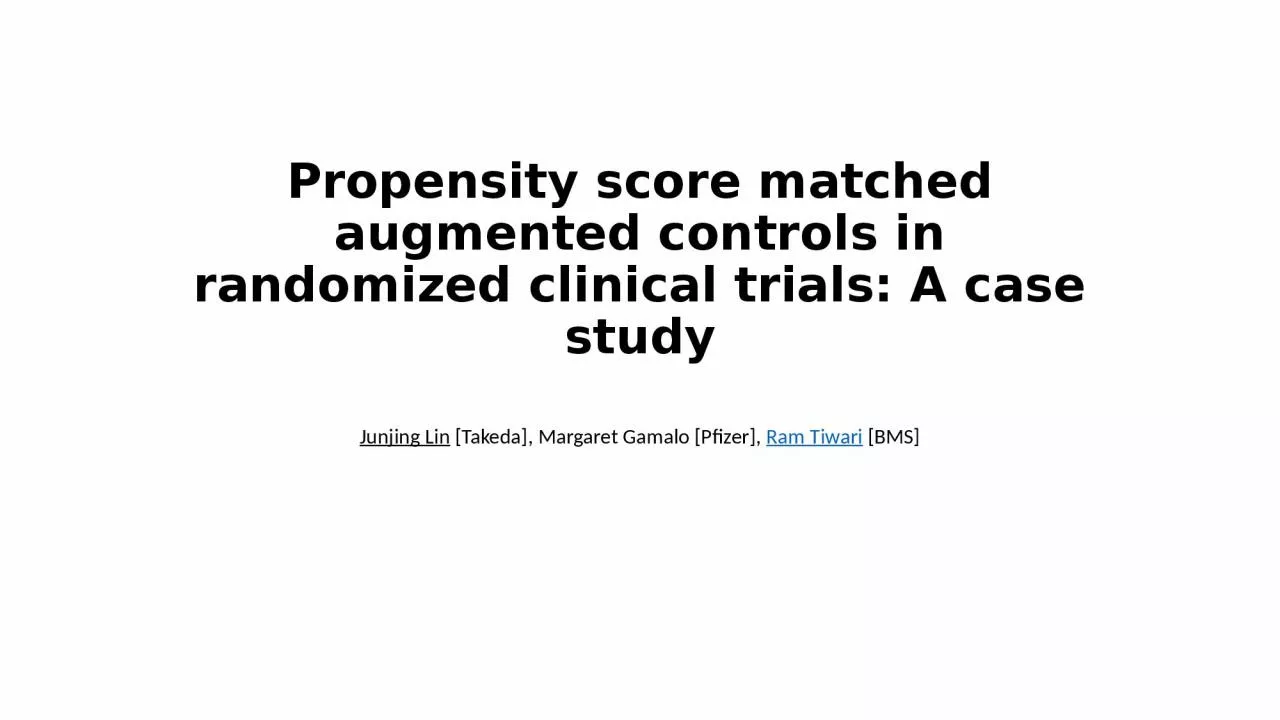

Junjing Lin Takeda Margaret Gamalo Pfizer Ram Tiwari BMS Expanding Real World Evidence in Premarket Approvals What Constitutes Externally Controlled Trials Potential Outcomes Framework ID: 1042389
Download Presentation The PPT/PDF document "Propensity score matched augmented contr..." is the property of its rightful owner. Permission is granted to download and print the materials on this web site for personal, non-commercial use only, and to display it on your personal computer provided you do not modify the materials and that you retain all copyright notices contained in the materials. By downloading content from our website, you accept the terms of this agreement.
1. Propensity score matched augmented controls in randomized clinical trials: A case studyJunjing Lin [Takeda], Margaret Gamalo [Pfizer], Ram Tiwari [BMS]
2.
3. Expanding Real World Evidence in Pre-market Approvals
4. What Constitutes Externally Controlled Trials?
5. Potential Outcomes Framework observations from a sample of N subjects outcome treatment indicator (1: investigational treatment, 0: control): baseline covariates, : potential outcomes
6. Potential Outcomes FrameworkEstimate , average treatment effect (ATE)In RCT, , because In non-randomized trials, as not independent with and It may be possible to identify a subset of characteristics such that Then
7. Propensity ScorePropensity Score: Proposition (Rosenbaum and Rubin, 1983): , then has all the information about that is in As a consequence, the propensity score allows the design and analysis of a non-randomized study that mimics some of the characteristics of a randomized trialEstimation:
8. Estimates of Average Treatment Effect After matching, an estimate and of and , respectively, is given by and where , It can be shown that is consistent for the true differenceThe large sample variance can be obtained by appealing to M-estimation theory.
9. Scheme 1: Pair-matchingScores of investigational group in RCT, , are pair-matched with scores of the external control group, . The number of needed matched observations, , are randomly selected from the pair-matched external controls
10. Scheme 2: Nearest-neighbor matching adjusted by caliperScores of investigational group in RCT, , are used to find the nearest control (concurrent and external) subjects in terms of estimated propensity scores. A caliper that confines the distance of the neighborhood are adjusted until the desired number of valid external controls, , are selected.
11. Scheme 1.1: Stratified Pair-matching
12. Scheme 1.2: Stratified pair-matching, need-based
13. Scheme 2.2: Stratified NN-matching, need-based
14. Simulation Experiments: DataTwo clinical trials, both with investigational drug v.s. active control The trials are similar, in terms of: Design, inclusion-exclusion criteriaBioequivalent formulation (Trial 1: oral; Trial 2, intravenous IV)Enrolled >600 adults with acute bacterial skin and skin structure infection (ABSSSI)Primary outcome: early clinical response (binary) at 48-72 hour visit
15. DataThe enrolled subjects between the two groups within each trial were well balanced in covariates, e.g., Demographics, some medical history, fever, Type, anatomical site of infectionPrior medications or procedures that have potential impactBaseline signs and symptomsHowever, between trial balance is not achieved, e.g., In Trial 1, about 41% had cellulitis/erysipelas, about 30% ad infected wound and another 30% have major cutaneous abscess,In Trial 2, about 50% had cellulitis/erysipelas, 30% had infected wound and 20% had major cutaneous abscess
16. Construct Asymmetrically Randomized DataRepeat 1000 times
17. Overlaid histograms of estimated propensity scores
18. Covariate Balance Check (Scheme 1)
19. Covariate Balance Check (Scheme 2)
20. Distribution of Estimates of Treatment Effect
21. Comparison of Matching Schemes
22. Comparison of Borrowing Sizes
23. DiscussionWhile RCTs are ideal, there is interest to look for innovative ways in areas with high unmet needOne approach is a design that relies on historical or supplemental control for data augmentationThe matched samples come from similar populations, characterized by pre-treatment factorsThe sample selection method does not rely on outcomes (cherry-picking avoided), and can be pre-specified before a trial is conducted Partially controlled trials provide advantage of RCT and the use of external control.